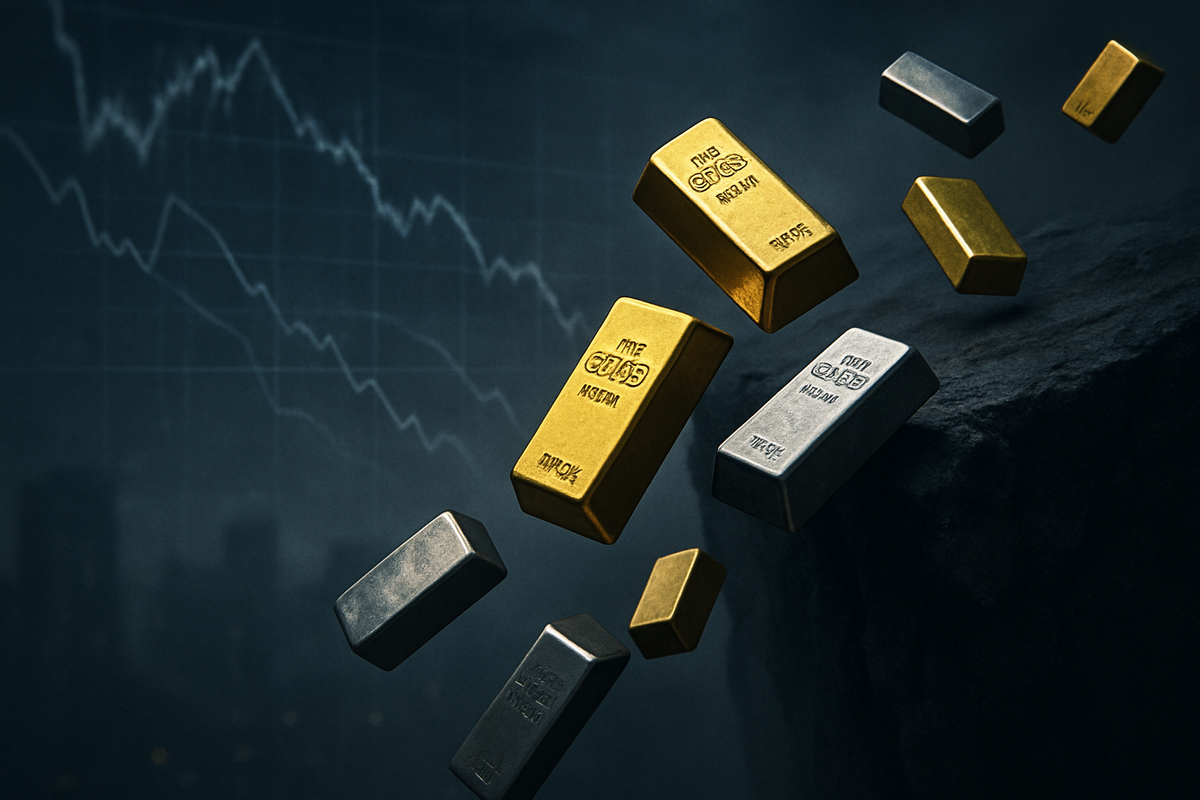
The precious metals market has been rocked by a dramatic downturn, with silver experiencing its steepest decline in years. On October 21, 2025, silver prices plunged by an astonishing 8.7%, settling at $47.89 per ounce, marking its largest single-day percentage drop since February 2021. This sharp correction follows an earlier 6% fall on October 17, 2025, and signals a significant cooling of the rally that had propelled silver to an all-time high of $54.49 per ounce earlier in the month, after an almost 80% surge throughout 2025. The sell-off is not isolated, as gold and other precious metals have also seen synchronized declines, indicating a broader market rebalancing and a shift in investor sentiment away from safe-haven assets.
This sudden reversal has immediate and far-reaching implications for investors, mining companies, and the broader financial landscape. The widespread profit-taking, driven by silver's technically overbought conditions, has triggered increased market volatility and raised concerns about liquidity. While some analysts view this as a healthy correction after an extended bull run, the intensity of the decline underscores a significant shift in market dynamics, influenced by an easing of global uncertainties and a strengthening U.S. dollar.
Market Dynamics: A Swift Correction Unfolds
The dramatic fall in silver prices, culminating in the October 21, 2025, plunge, was the result of a confluence of market forces. Prior to this correction, silver had enjoyed an extraordinary rally throughout 2025, reaching an all-time high of $54.49 per ounce. However, technical indicators, such as the Relative Strength Index (RSI), had signaled that the metal was deeply in overbought territory, making a pullback highly probable.
The timeline of events saw silver first dip over 6% on October 17, 2025, to $50.96 per ounce, followed by the even steeper 8.7% decline on October 21. This rapid succession of drops was primarily driven by extensive profit-taking from investors cashing in on the year's impressive gains. Key players in this scenario include large institutional investors and hedge funds, who are often quick to adjust positions based on technical signals and shifting market sentiment. Initial market reactions were characterized by widespread selling across the precious metals complex, with gold experiencing its largest single-day decline since 2013, falling 3.0% on October 17th and 6.3% on October 21st, reaching $4,082.03 an ounce. Platinum and palladium also saw significant losses.
Adding to the selling pressure was an easing of global uncertainties, including reduced fears over U.S. credit risks and U.S.-China trade tensions. Remarks from U.S. President Donald Trump that soothed anxiety around trade tensions contributed to a shift in risk sentiment, lessening the appeal of safe-haven assets like precious metals. Furthermore, a strengthening U.S. dollar made dollar-denominated commodities more expensive for international buyers, exacerbating the selling trend. A prior liquidity crunch in London's silver market, which had triggered a global scramble for physical supply, also began to show signs of easing, potentially contributing to profit-taking as supply concerns abated.
Companies on the Brink: Winners and Losers in the Precious Metals Shake-Up
The recent precipitous drop in silver and other precious metals prices is set to have a profound impact on public companies operating within the mining and investment sectors. Mining companies, particularly those with significant exposure to silver, are likely to face immediate headwinds. Their profitability is directly tied to commodity prices, and a sharp decline can quickly erode margins, reduce cash flow, and potentially lead to downward revisions in earnings forecasts.
Companies like Pan American Silver Corp. (NASDAQ: PAAS), Hecla Mining Company (NYSE: HL), and First Majestic Silver Corp. (NYSE: AG) are among those that could be significantly impacted. These pure-play or heavily weighted silver producers will see the value of their mined output decrease, potentially affecting their ability to fund operations, exploration, or debt servicing. Share prices of these companies have already experienced premarket declines, reflecting investor concerns about their profitability outlook. For instance, a sustained period of lower silver prices could force some higher-cost mines to reduce production or even temporarily shut down, impacting employment and local economies.
Conversely, companies that utilize silver as an input in their manufacturing processes might see some relief. Industries such as electronics, solar panel production, and photography, which rely on silver's unique conductive and reflective properties, could benefit from lower raw material costs. This might include tech giants or specialized manufacturers, though the impact on their overall profitability might be less direct compared to mining companies. Furthermore, some investment firms or hedge funds that had short positions on silver or precious metals, anticipating a correction, would have profited handsomely from this downturn. Those with diversified portfolios, or those who took profits earlier in the rally, are also better positioned to weather the storm.
Wider Significance: A Reset in the Commodity Landscape
This significant correction in the precious metals market, led by silver's steep decline, fits into a broader narrative of market rebalancing and a potential reset in the commodity landscape. For much of 2025, precious metals benefited from heightened geopolitical tensions, inflation concerns, and a flight to safety. The current downturn suggests a shift in these underlying drivers.
The ripple effects extend beyond mining companies to the broader financial ecosystem. Investment funds focused on commodities or precious metals ETFs (Exchange Traded Funds) will see their asset values decline, potentially triggering redemptions from investors. This could create further selling pressure in the market. From a regulatory or policy perspective, a sustained period of lower commodity prices might ease inflationary pressures, potentially influencing central bank decisions on interest rates. However, there are no immediate regulatory changes directly tied to this price movement. Historically, sharp corrections in commodity markets often follow periods of rapid appreciation. For example, the gold market has seen similar dramatic pullbacks after significant rallies, such as in 2013, when it experienced a sharp decline after a multi-year bull run. These events often serve as a "washout" for speculative positions, paving the way for more sustainable growth based on fundamental demand.
This event also highlights the cyclical nature of commodity markets and the importance of understanding both macro-economic factors and technical indicators. While reduced safe-haven demand played a role, the technical overbought conditions were a clear warning sign. The cooling of U.S.-China trade tensions and a stronger U.S. dollar are significant macro trends that are currently exerting downward pressure on the entire commodity complex, signaling a potential shift in global economic sentiment and risk appetite.
What Comes Next: Navigating Volatility and Emerging Opportunities
Looking ahead, the precious metals market, particularly silver, is likely to experience continued volatility in the short term. The intensity of the recent sell-off suggests that a period of consolidation and price discovery is probable as investors reassess their positions. Short-term possibilities include further downward pressure if risk sentiment continues to improve and the U.S. dollar strengthens further. However, a significant rebound is also possible if geopolitical tensions flare up again or if inflation concerns resurface.
In the long term, the fundamentals for silver, including its industrial demand in sectors like solar energy and electronics, are expected to remain robust. This could provide a floor for prices once the speculative froth has been cleared. Strategic pivots or adaptations required for mining companies might include cost-cutting measures, optimizing production, or diversifying their commodity exposure. For investors, this period of correction could present market opportunities to acquire silver and gold at more attractive valuations, especially for those with a long-term bullish outlook on precious metals.
Potential scenarios and outcomes vary. A "healthy correction" scenario would see prices stabilize and then gradually resume an upward trend, driven by underlying demand. A more bearish scenario could see prices languish for an extended period if global economic growth slows significantly or if central banks adopt more hawkish monetary policies. Investors should closely monitor macroeconomic data, geopolitical developments, and the strength of the U.S. dollar, as these factors will be crucial in determining the next direction for precious metals. The market will also be watching for any signs of renewed physical demand or changes in central bank gold accumulation, which could provide support.
Comprehensive Wrap-Up: A Market in Transition
The steepest drop in silver prices in years, alongside a synchronized decline in gold and other precious metals, marks a significant turning point for the commodity market. The key takeaways from this event include the unwinding of speculative positions, the impact of easing global uncertainties, and the influence of a strengthening U.S. dollar. While the immediate implications are a period of heightened volatility and pressure on mining companies, many analysts view this as a necessary technical correction after an extended rally.
Moving forward, the market will be characterized by a re-evaluation of risk and a search for new equilibrium prices. Investors should assess their exposure to precious metals, considering both the potential for further short-term declines and the long-term fundamental drivers that could eventually support a recovery. The event underscores that even in a bull market, sharp corrections are an inherent risk, and technical indicators, combined with macroeconomic analysis, are crucial for navigating such shifts.
What investors should watch for in the coming months includes the trajectory of the U.S. dollar, any resurgence in geopolitical tensions, central bank monetary policy decisions, and industrial demand data for silver. While the recent rally has cooled considerably, the underlying appeal of precious metals as a store of value and an an industrial commodity remains. This period represents a market in transition, offering both challenges and potential opportunities for discerning investors.
This content is intended for informational purposes only and is not financial advice






